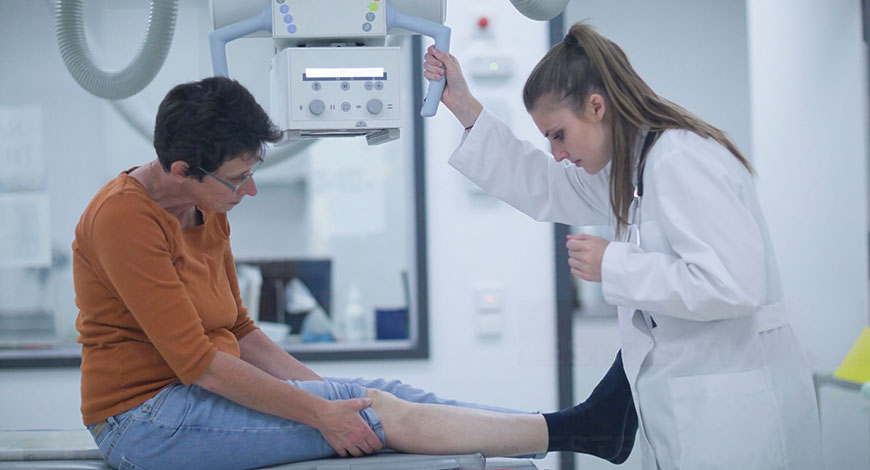MB Stories
Delivering innovation

From augmented reality to virtual reality to robotics to new procedural techniques – the future of radiology is bright.
A new year — and decade — offer the opportunity to reflect on the advancements and challenges of years gone by and ponder on what’s next? For radiologists, constant innovations in medical technology mean the landscape may not look the same year over year, or certainly from decade to decade. The digital transformation wave, which started taking shape in India in 2019, took a major leap in 2020, with the COVID-19 pandemic and subsequent lockdowns enabling further innovation using digital technologies. With the increasing burden on healthcare facilities requiring faster and more efficient ways of diagnosis, especially in X-rays, the industry saw a swift move to the digital X-ray technologies, marking a radical transformation from conventional X-ray imaging based on analog and computed technologies. This shift also came in because of the various hygiene protocols adopted by healthcare workers while imaging during the COVID crisis. With digitized X-ray systems in place, the numbers of sanitization steps are reduced, especially for mobile systems kept in isolation wards.
The X-ray market is also witnessing some path-breaking innovations in the field of Artificial Intelligence (AI), where several algorithms and programs are being designed to aid the healthcare workers. These technological innovations in X-ray system has helped in streamlining processes at the healthcare institutions with reduction in time (as compared to analog technology, which takes 2 hours to complete and generate a finalized film, the digital scan takes under 10 seconds), quality output, and enhanced patient experience.
 Venkatesan N
Venkatesan N
VP–Group Head of
Supply Chain & Procurement,
HCG
“In the recent years, diagnostic radiology has greatly advanced with the development of new instruments and techniques. Imaging system plays a vital role for diagnose and better detect the cancer and also help patients avoid surgery. Hence, we buy all the high-end latest technology of imaging systems like digital X-ray, digital radiography systems, digital PET CT, digital pathology etc., we have the state-of-the-art equipment in our hospital. With this technology support we can reduce the patient’s waiting time for the diagnosis and helps us to start the patient’s further diagnosis/treatment process faster. Right now, hospitals are paying high cost to import some of the latest technology imaging equipment. Indian manufacturers should shape the future of manufacturing the equipment in India and the price advantage should be passed on to the hospitals, so that every hospital can have this equipment for early diagnosis of the disease.”
Aggressive technology partnerships with AI vendors in X-ray specificities highlight India’s willingness to embrace AI-led chest X-ray scanning for effective diagnosis and triaging of COVID-19 cases. The current crisis has given rise to several partnerships in India, including Behold.ai’s partnership with Apollo Hospitals to implement AI-based chest X-ray technology, and the joint initiative by NTT Data Corporation and DeepTekInc to use AI technology to analyze patient’s images from X-ray and CT and enhance the efficacy of triaging. Though the AI-led technology partnerships with hospitals continue to rise, the National Informatics Centre (NIC) of India is still awaiting a diverse pool of sampling of chest X-rays to use the data to create a prototype for COVID-19 detection throughout the country.
Considering the current COVID-19 scenario in India, the Ministry of Healthcare is planning to devise structural strategies for technology partnerships. But there is a cautious approach when it comes to embracing AI in X-ray, even though it will curb the ongoing operational changes when handled effectively. Further, there will be an uptick in the adoption of cloud implementation, picture archiving and communication systems (PACS), and vendor-neutral archive (VNA) channels among healthcare providers as healthcare companies facilitate a seamless adoption of the technology-enabled models to engage patients, and for remote engagement strategies.
In general, the fundamental drivers of AI adoption look set to remain robust despite the impact of the pandemic; while some deals will have been delayed, it is expected that the impact will be only be short-term. Reduced budgets for AI projects, especially those that are not directly related to COVID-19, such as neurology, liver, prostate, and musculoskeletal applications could likely be felt in 2021, as 2020 revenues will be somewhat supported by projects that were initiated pre-COVID.
 Dr Ankush Sethi
Dr Ankush Sethi
Radiology Resident,
Christian Medical College and Hospital
“The first ever X-ray taken of a human (on December 22, 1985) was the left hand of Anna Bertha Roentgen. Wilhelm Conrad Roentgen was a German mechanical engineer and physicist, who on 8 November 1895 produced and detected electromagnetic radiation in a wavelength range known as X-rays or Roentgen rays, an achievement that earned him the inaugural Nobel Prize in Physics in 1901. X-rays represent a form of ionizing electromagnetic radiation (with wavelengths ranging from 0.01 to 10 nanometers). Recent in X rays include: Chest X-ray is not reliable in detecting COVID-19 lung infection. Chest X-rays taken in COVID-19 positive patients can appear normal or reveal mild disease. Chest X-ray can predict COVID-19 severity in young and middle aged emergency room patients-who are at higher risk for developing severe disease and require intubation”
Researchers have developed a new material that could be used to make flexible X-ray detectors that are less harmful to the environment and cost less than existing technologies.
The team led by Biwu Ma, a professor in the Department of Chemistry and Biochemistry, Florida State University, USA created X-ray scintillators that use an environmentally friendly material. Their research was published in the journal, Nature Communications in August 2020.
“Developing low-cost scintillation materials that can be easily manufactured and that perform well remains a great challenge,” Ma said. “This work paves the way for exploring new approaches to create these important devices.”
Biwu Ma and his colleagues convert the radiation of an X-ray into visible light, and they are a common type of X-ray detector. At the dentist or an airport, scintillators are used to take images of the teeth or scan the luggage.
Various materials have been used to make X-ray scintillators, but they can be difficult or expensive to manufacture. Some recent developments use compounds that include lead, but the toxicity of lead could be a concern.
Ma’s team found a different solution. They used the compound organic manganese halide to create scintillators that do not use lead or heavy metals. The compound can be used to make a powder that performs very well for imaging and can be combined with a polymer to create a flexible composite that can be used as a scintillator. That flexibility broadens the potential use of this technology.
“Researchers have made scintillators with a variety of compounds, but this technology offers something that combines low cost with high performance and environmentally friendly materials,” Ma said. “When you also consider the ability to make flexible scintillators, it is a promising avenue to explore.”
Ma recently received a GAP Commercialization Investment Program grant from the FSU Office of the Vice President for Research to develop this technology. The grants help faculty members turn their research into possible commercial products.
 Dr Amogh VN
Dr Amogh VN
Consultant,
Aster RV Hospital
“X-ray technology has seen interesting developments in the recent years. A significant advancement in radiography includes the introduction of DR systems with the integration of AI, started in 2019 to flag immediate critical findings. This has recently received US FDA approvals and helps technologists notify the attending radiologists on any important findings from the X-ray. Another important development is glassless DR plates–the first glassless plate, which is a flexible plastic film was introduced in 2019, is affordable, lightweight, and more durable, making it better than the present glass plate. We also have moving X-ray images now. Dynamic DR was developed to create moving X-ray images. It uses continuous pulses of about 15 frames/sec to capture respiratory motions with lower radiation dose. Similarly, dural-energy DR imaging is another recent technology that has entered the market which uses dual energy X-ray technology to differentiate between bone and soft tissue contrasts. Finally, efforts are there to create tomosynthesis X-ray imaging, which makes an automated sweep of 30 frames/sec at different angles to create a multi-slice data set, similar to a CT scan”
X-ray imaging is a cornerstone of modern medicine, but it comes with substantial risk for patients and healthcare providers. CT scanners, fluoroscopes, and mammography machines have to produce a great deal of ionizing radiation because existing silicon-based detectors are not very efficient at capturing incoming X-rays. Most of the radiation passes through existing detectors. Now, researchers at Los Alamos and Argonne National Laboratories, New Mexico, USA have developed an X-ray detector based on perovskite, a calcium titanium oxide mineral that is orders of magnitude more sensitive than conventional silicon detectors. More sensitive detectors will allow X-ray-based imaging systems to reduce the radiation dose that they deliver and improve their image fidelity.
The new detector is about 100 times more sensitive than silicon devices and it does not need a power source, as it uses the incoming X-ray energy to generate the output electric signal. Another advantage of the new detector is that its core, the perovskite thin film, can be sprayed onto surfaces, unlike silicon devices that need metal deposition and high-temperature to be created.
“The perovskite material at the heart of our detector prototype can be produced with low-cost fabrication techniques,” said Hsinhan (Dave) Tsai, a postdoctoral fellow at Los Alamos National Laboratory. “The result is a cost-effective, highly sensitive, and self-powered detector that could radically improve existing X-ray detectors, and potentially lead to a host of unforeseen applications. Potentially, we could use ink-jet types of systems to print large scale detectors. This would allow us to replace half-million-dollar silicon detector arrays with inexpensive, higher-resolution perovskite alternatives.”
Evolving advances in augmented reality, Artificial Intelligence (AI), imaging modalities, robotics, and procedural techniques will play a big role in the future and facilitate further exponential growth.
In augmented reality, virtual images can be seen alongside real images. In contrast to virtual reality where the field of vision includes no real images, augmented reality offers the ability to maneuver objects and interact with the real world. This powerful development has wide-ranging applications for image-guided interventions. For example, an interventional radiologist could visualize vital signs within the same field of vision, overlying the patient during a critical intervention. These numbers could potentially appear on command when performing a key step of a procedure or when the radiologist has a concern.
Needle placement or a procedure with an image-guided device is another application. For instance, the operator could also view a fused ultrasound image, during simultaneous visualization of needle insertion and ultrasound probe manipulations. Augmented reality can also be used to visualize anatomy underneath procedural drapes to guide an intervention when there is poor sonographic penetration or fluoroscopic guidance is insufficient. For example, a projected 3D hologram, recreated from a pre-programmed CT scan, can help the radiologist identify–and avoid–key structures during a percutaneous intervention, which may otherwise be invisible.
Recent developments in AI represent additional revolutionary opportunities of growth in the current and future practice of image-guided interventions. Utilizing AI, outcomes of interventions can be more accurately and quickly predicted, improving patient outcomes. Machine learning algorithms will be able to augment the interventional radiologist in guiding treatment decisions and selecting patient populations that would benefit most from interventions in areas, such as interventional oncology, where multimodal therapies abound.
Other future applications will include intraprocedural augmentation for the interventional radiologist. AI will enhance image guidance through anatomical recognition, to facilitate interventions and guide the operator through complex anatomy. Lastly, promising applications exist in the treatment of patients requiring time-sensitive interventions. Conditions, such as strokes and pulmonary embolisms, have been described to benefit from AI’s impact on expediting recognition and throughput to improve patient outcomes.
Furthermore, continued enhancement of current image-guidance modalities and development of new ones will enhance future procedural practice. Limitations of current imaging modalities in interventional radiology include two-dimensionality and, oftentimes, radiation exposure. One new imaging guidance modality currently being pioneered is Fiber Optic RealShape (FORS). This imaging technology utilizes catheters embedded with light sensing technology. Currently, physicians are challenged by tortuous and diseased vasculature, which is difficult to visualize in 2D and often presents technical challenges to operators driving the catheter. Technologies, such as FORS and other evolving modalities, could optimize vascular imaging guidance, drastically decrease the procedural time, and radiation exposure for interventions, drastically increasing the safety for patients and practitioners alike in the future.
Another area with future potential in imaging-guided interventions is robotics, which has already been integrated into many fields of medicine. Oftentimes, in order for robotic systems to flourish in utilization, there must be a proven clinical benefit.
Robotics have been applied to many endovascular procedures. Uterine artery embolization, cardiac ablation, and aneurysm repair have all been successfully performed with robotic navigation systems. Radiographic procedures are uniquely positioned to benefit from robotics due to added benefits to the operators. The interventionalists can work in a separate room from the procedural suite, thereby shielding them from radiation exposure and musculoskeletal injury from heavy protective aprons. More research, however, is needed to justify the cost of such systems, but it is expected that robotics will become more prominent in interventional suites. It is essential that benefits to the operator safety will not compromise patient outcomes, and quality-control studies continue to be rigorously applied and performed.
Lastly, the scope of practice of interventional radiology itself is expanding, as well. In addition to advancements in existing procedures and techniques, interventional radiologists are developing new procedures to address conditions, such as arthritis, obesity, and benign prostatic hypertrophy. Many of these procedures have been validated in small scale clinical trials. Chronic arthritis pain is being managed through embolization of hyperemic synovial tissue. The left gastric artery has been embolized to decrease fundus blood flow, thereby restricting growth of ghrelin-producing cells and decreasing appetite. Radiologists can also treat lower urinary tract symptoms through decreasing the size of the prostate with embolization. Endovascular approaches continue to be identified as a way to treat conditions formerly managed with invasive surgeries and medication therapies. The future is bright as the value proposition of interventional radiology offering minimally invasive, high-quality, low-complication, cost-effective therapies align extremely well with the future of medicine and healthcare.
Advancements in technology will foster improvements in efficiency, efficacy, and safety for interventional radiology and image-guided interventions. The degree of innovation and changing practice patterns will continue to be exponential, alongside exponential growth in technology. Interventional radiologists will be presented with ample opportunity to adapt and invent. This is an exciting challenge, and will mean a brighter future for patients.
Even though it has not been the predominantly discussed imaging modality during the COVID-19 pandemic this year, X-ray has played a major part in detecting and managing the disease. All year long, researchers continued to unearth the most – and least – effective ways the modality could be used during the outbreak. But, they also investigated ways to improve its use with a variety of conditions and patient populations.
Chest X-rays taken in COVID-19-positive patients can appear normal or only reveal mild disease. In a Journal of Urgent Care Medicine study, Ohio State University College of Medicine researchers examined chest X-rays performed in an ambulatory population because that is the setting where most people will initially seek treatment for COVID-19-related symptoms, and they found that, X-rays determined 89 percent of scans were negative or mild.
Take-away message. Radiologists should be aware that most COVID-19-positive patients can have little-to-no evidence of infection on X-ray.
X-ray will remain a cornerstone in diagnostic imaging and is an area for radiologists and radiology groups to assess any challenges they are facing for potential solutions and new strategies. The need to address X-ray in the delivery of care is expected to grow, regardless of growth and priorities in other specialty areas of imaging, resulting in a need for high-quality, high-volume radiologists who are adept at interpretation.
The work approach of radiologists and other imaging personnel is expected to change in the future given new technology innovations, such as Artificial Intelligence and natural language processing impacting diagnostic imaging, there is still a road to travel until value propositions and offerings are fully realized in the market.
Given the tight job market in radiology, organizations are striving to attract and keep the best talent in place. An approach to achieve this is to ensure radiologists have both high job satisfaction and high engagement, thereby lowering the possibility of burnout and turnover. Making decisions by involving collaborative feedback from the radiologists can prevent situations where their organization’s desire for economies of scale and skill is at the expense of radiologists and contributes to burnout.
Both the shortage of available radiologists and the use of X-ray are not going away in healthcare.
Radiology groups need to acknowledge the severity of the challenges today and consider strategies that enable their radiologists to work smarter and not merely work harder. New strategies to enable radiologists to focus on areas of imaging they find more rewarding, such as areas of specialization, to drive productivity and TAT while combating burnout, to address volume, and to have an improved work experience will play an important role in radiology groups being best prepared for today and the future.












